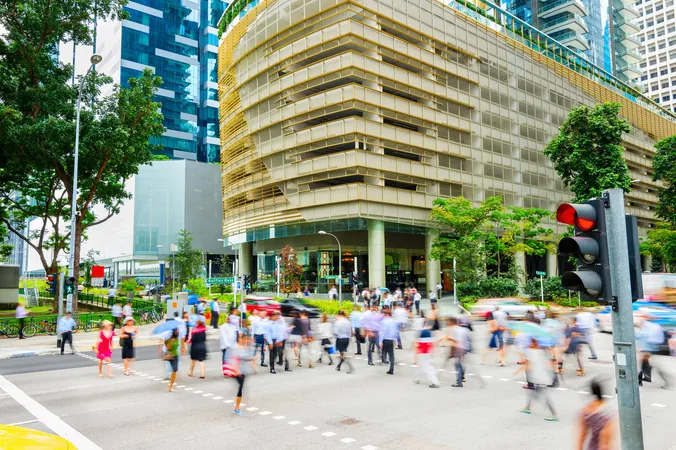
Singaporeans Express Major Discontent with Hybrid Work Model, Reveals Global Survey
2024-09-20
SINGAPORE: A recent global workplace survey by Unispace, titled From Restrictions to Resilience, has painted a troubling picture of employee satisfaction in Singapore, with local workers reported as the most dissatisfied when it comes to hybrid work arrangements compared to other nations.
Despite the growing trend of hybrid work, many Singaporeans feel that their current setups lack essential components, particularly "quiet" workspaces and the desired level of flexibility.
Interestingly, this dissatisfaction contrasts markedly with the feelings of employers in Singapore, who are overwhelmingly pleased with the current work conditions. In fact, 94% of employers reported high satisfaction levels, closely mirroring the global average of 95%.
In response to the rising discontent among workers, the Singaporean government rolled out the Tripartite Guidelines for Flexible Work Arrangements early this year, with an implementation date set for December 2024.
This initiative is aimed at bridging the gap between employers' offerings and employees' expectations.
Jianhan Qiu, Principal of Strategy (Asia) at Unispace Singapore, commented on the disparity, saying, "With the high dissatisfaction among Singapore workers, it’s not very surprising that the government has formalized flexible working arrangements this year."
He emphasized that flexible scheduling tops the list of employee desires for the next five years. However, he cautioned that employers must take proactive steps to modernize their physical work environments to meet these new expectations.
While attitudes toward returning to the office have shifted, employees still spend around 67% of their office hours working alone at their desks, underscoring a need for dedicated quiet spaces for focused work.
Qiu pointed out that many workers find themselves confined to cramped phone booths or noisy cubicles, harshly reminiscent of pre-Covid work designs that no longer serve today's needs.
Moreover, the survey revealed that 87% of Singaporean employees would prefer spending more time at the office if they had the option for flexible start times.
An impressive 92% expressed interest in exploring a four-day workweek, indicating a strong desire for a more adaptable work life.
Singaporean employees highlighted that elements such as quiet areas, good lighting, and reliable technology are fundamental for maximizing productivity.
However, only 64% feel that their workplace facilitates their best work compared to the global norm of 71%.
To tackle these issues, the report suggests major changes in office design, advocating for the creation of quiet zones for focused tasks alongside collaborative spaces, aimed at enhancing both concentration and teamwork harmoniously.
The survey also uncovers a generational divide when it comes to workplace preferences.
Younger employees aged 18 to 34 tend to see the office as a collaborative environment, averaging only 3.5 days a week in the office. They favor remote work but are attracted to office perks.
Conversely, older employees (55+) spend an average of 4.3 days in the office, valuing it more for leadership duties and deep work.
Mr. Qiu emphasized that flexibility and appealing amenities—not mandates—drive the attendance of younger workers.
Despite a general drop in camaraderie and belonging within organizations—only 30% of Singaporeans feeling a sense of connection compared to 40% globally—71% of employees indicated they would be more inclined to spend extra time in the office if the space reflected their company’s branding and culture.
With Generation Z set to comprise around 25% of the APAC population and approximately 27% of the workforce by 2025, this is a critical moment for employers to reflect on whether they are ready to invest in creating appealing work environments that attract and retain top talent.
The implications of this survey are profound. As workplaces adapt to the evolving workforce landscape, will Singaporean employers heed the call for change, or continue to face a disengaged and dissatisfied workforce? Only time will tell.





 Brasil (PT)
Brasil (PT)
 Canada (EN)
Canada (EN)
 Chile (ES)
Chile (ES)
 España (ES)
España (ES)
 France (FR)
France (FR)
 Hong Kong (EN)
Hong Kong (EN)
 Italia (IT)
Italia (IT)
 日本 (JA)
日本 (JA)
 Magyarország (HU)
Magyarország (HU)
 Norge (NO)
Norge (NO)
 Polska (PL)
Polska (PL)
 Schweiz (DE)
Schweiz (DE)
 Singapore (EN)
Singapore (EN)
 Sverige (SV)
Sverige (SV)
 Suomi (FI)
Suomi (FI)
 Türkiye (TR)
Türkiye (TR)